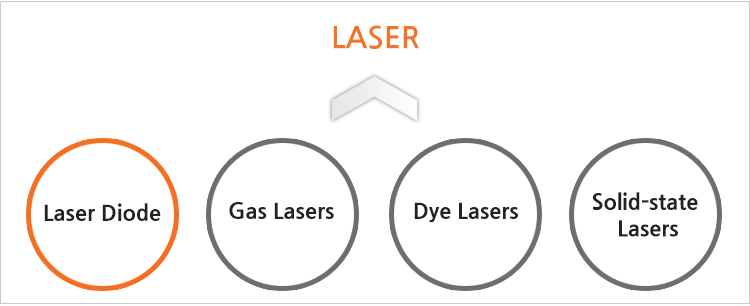-
COMPANY
COMPANY
We create the future that is
much better than today.
Greeting Company Outline History CI Social Contribution Location
-
PRODUCT
PRODUCT
Laser Diode that is produced by superb
competitiveness & high technical skills.
Red laser diode Infra Red laser diode Certification Epi wafer
-
CYBER PR
CYBER PR
We will become a leading company
that grows with our customers.
What's news PR Movie About LD QSI Photo QSI Competitiveness Global Customers
-
Contact US
Contact US
We will grow in becoming a leading enterprise
that is recognized world-wide.
About LD
HOME > CYBER PR > About LD
Laser Diode
- The laser diode has electrons and positive holes combined to create light from the PN junction when a PN junction is made by combining an N-Type semiconductor & P-Type semiconductor while afterwards, having the currents injected as a forward current. The created light is reflected from the cross sections of a CHIP that has reflectivity of the light that has been created while as the light gradually amplifies, it makes it possible for the laser to squeg.
Characteristics of Laser
- Light (natural light) is a type of an electromagnetic wave and by how long or short its wavelength is, the level of refraction is revealed and the shorter the wavelength is, the bigger the refraction level becomes and the longer the wavelength is, the smaller the level of refraction becomes as well.
- The color blue that has short wavelengths is made within while it creates a tinge in the order of green, yellow and red.
- As for lasers, its path does bend by the refraction when it’s in same conditions but there are no changes to the colors.
- The light from the laser is a single light.

1. Monochromaticity
- Light is not mixed and some level of pure light appears
- The color blue that has short wavelengths is made within while it creates a tinge in the order of green, yellow and red.

2. Directivity
- Light does not spread out and shows the level of how much it moves forward in a certain direction.
- For example, light from lamps have their light to expand by it moving forward but the light from lasers does move forward but doesn't expand like lamps.

3. Indirectness
- Interference is an effect that means by the difference of the phase, the pattern of light and shade appears.
- Since the phase of lasers is even, it shows interferences once it softly bumps into an obstacle.
- However, various interferences or frequencies & phrases are difficult for standard light such as sunlight to create.

4. Level of concentration & high luminance of energy
- Since laser light has high energy density, it can even burn iron plates but when sunlight is concentrated on the lenses, it can only burn at a level of paper or wood.
Types of Lasers
- Depending on the types of the laser's medium, various types are available such as solid lasers, gas lasers, liquid lasers, semiconductor lasers, etc.
- Laser Diode - Diode lasers can also be called semiconductor lasers. Compared to other lasers, the size is very small and uses small amounts of electricity as well. It can be composed by array and used as a source of light for laser printers or light-using storing devices.
- Solid-state Lasers - The medium is formed by solids such as rubies, Nd-YAG etc. and for the Nd-YAG laser, wavelengths are at 1064nm, 532nm etc. (1nm =10 - 9 m)
- Gas Lasers - With the laser's medium being gas, typical lasers can be He lasers & HeNe lasers while red light is released. As for CO 2 lasers, wavelengths are a far-infrared light and is used when cutting substances.
- Dye Lasers - As a medium, complex organic dyes that exist within the liquids are used. Dye lasers have a characteristic where their wavelengths can be adjusted.

Characteristics of Lasers Diode
- Compared to other lasers, it is smaller-sized and light weight.
Example) A 1mW He-Ne laser is 30㎜×250㎜ in size. Even in tens of mW devices, a semiconductor laser is 0.3㎜×0.4㎜×0.5㎜ in size . - As the spectrum's width of the output light is narrow, it can be used as a concentrated light.
- When more current flows than the critical current value, the laser is oscillated and increases its lighting output.
- Output is a few mW but there are bigger-sized outputs that can provide at dozens of W.
- Modulation is easy and when the current is modified, the lighting condition that is being emitted (Intensity, frequency, etc.) also changes. (LD used for communications can be modulated into a few ㎓)
- High brightness : A level of the brightness and intensity of light
- Low use of electricity
- By the temperature, the oscillation wavelengths changes at an overall condition of 0.3㎚/℃ (GaAs) ∼ 0.5㎚/℃ (GaInAsP/InP)
- The selection range of wavelengths are broad at 0.33㎛∼28㎛.

